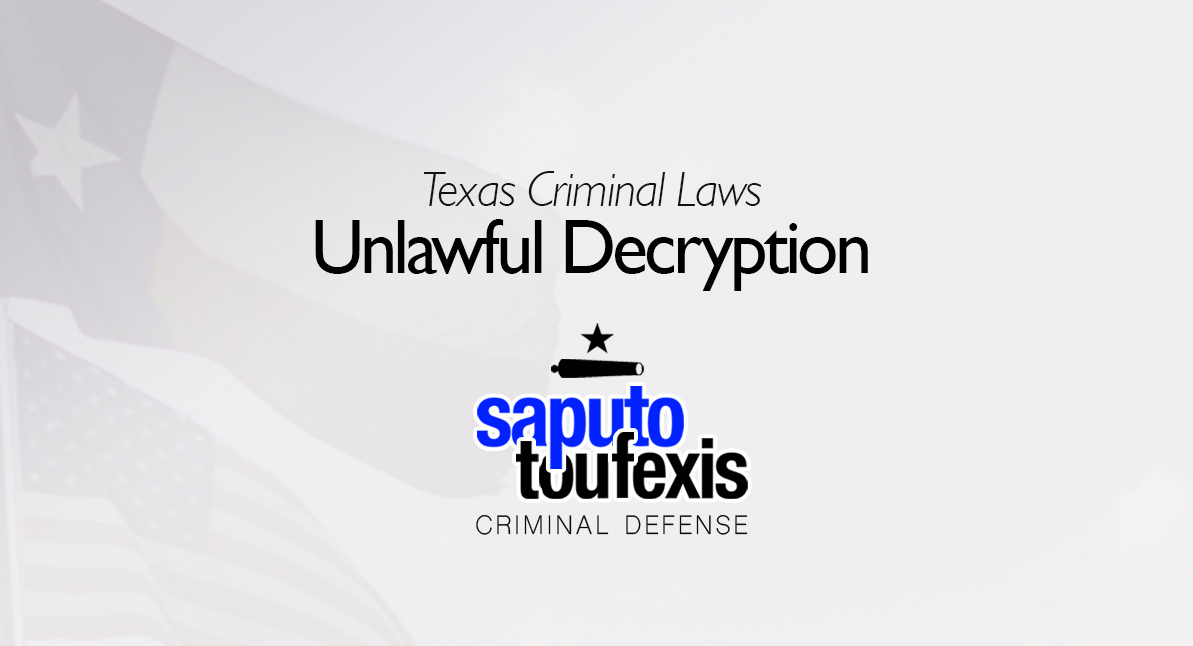The Texas Unlawful Decryption law in Penal Code Section 33.024 makes it illegal to decrypt private encrypted information without a legitimate business purpose.
FAQs about the
Unlawful Decryption law in Texas
- What is the current Texas law about Unlawful Decryption?
- Are there any affirmative defenses for Unlawful Decryption?
- How is decryption defined under the law?
- What is the statute of limitation for Unlawful Decryption in Texas?
- What is the penalty for a Texas Unlawful Decryption offense?
- Can you get probation for Unlawful Decryption in Texas?
- What level of crime is Unlawful Decryption in Texas?
The legislature created the Unlawful Decryption law as part of the Texas Cybercrime Act in response to growing concern about cybercrime in Texas.
Have you been charged with Unlawful Decryption? Contact us today to discuss legal representation.
or Text or Call (888) 239-9305
The Texas legislature codified this criminal offense in Texas Penal Code Section 33.024. The law was not updated in 2023. In fact, this law has not been amended since it was enacted in 2017.
The penalty for violations of this law range from a Class C misdemeanor to a first degree felony, depending on whether the person obtained benefits or caused the victim to incur losses, whether the information restricted was privileged, and the total amount of benefits obtained or losses incurred.
The Penal Code classifies the Texas Unlawful Decryption law under Title 7 “Offenses Against Property,” Chapter 33 “Computer Crimes.” Learn more about the Texas offense of Unlawful Decryption below.
What is the current Texas law about Unlawful Decryption?
Texas law currently defines the offense of Unlawful Decryption in Penal Code Section §33.024 as follows:[1]
(a) A person commits an offense if the person intentionally decrypts encrypted private information through deception and without a legitimate business purpose.
This law was created by the 85th Texas Legislature and was codified at Section 33.024 in the Texas Penal Code, effective September 1, 2017.[2]
The Unlawful Decryption law was one of three new offenses created by in same bill in the 85th Legislature in 2017, the others being Electronic Data Tampering and Electronic Access Interference.
Are there any affirmative defenses for Unlawful Decryption?
The law offers an affirmative defense to anyone charged with Unlawful Decryption, which requires you to prove that the decryption “was pursuant to an agreement entered into with the owner for the purpose of (1) assessing or maintaining the security of the information or of a computer, computer network, or computer system; or (2) providing other services related to security.”[3]
How is decryption defined under the law?
Under the Texas Cybercrime Act passed in 2017 and still in effect today, “decryption” is defined as “the decoding of encrypted communications or information, whether by use of a decryption key, by breaking an encryption formula or algorithm, or by the interference with a person’s use of an encryption service in a manner that causes information or communications to be stored or transmitted without encryption.”[4] Decryption is the conversion of code or ciphertext back into its original plaintext form.
What is the statute of limitation for Unlawful Decryption in Texas?
Misdemeanor level Unlawful Decryption charges have a two-year limitations period.[5] Felony level offenses have a three-year limitations period.[6]
What is the penalty for a Texas Unlawful Decryption offense?
The penalty scheme for Unlawful Decryption convictions is somewhat complex. By default, the offense is classified a Class C misdemeanor, but the punishment can be enhanced all the way up to a First Degree Felony, depending on whether the convicted person obtained benefits or caused the victim to incur losses, whether the information restricted was privileged, and the total amount of benefits obtained or losses incurred.[7]
Can you get probation for Unlawful Decryption in Texas?
The Texas Code of Criminal Procedure allows both judges and juries to grant probation for Unlawful Decryption, and judges are also allowed to accept deferred adjudication plea deals.[8]
Note, however, that no matter the offense, neither judges nor juries may recommend community supervision for any suspended sentence of over 10 years.[9] Also, judges may not grant community supervision after a conviction if (1) the defendant used or exhibited a deadly weapon during the commission of the felony or immediate flight thereafter and (2) the defendant used or exhibited the deadly weapon himself or was a party to the offense and knew that a deadly weapon would be used or exhibited.[10]
What level of crime is Unlawful Decryption in Texas?
The Penal Code classification of the punishment for Unlawful Decryption ranges from a Class C misdemeanor to a first degree felony, depending on the amount involved and other factors.
Learn more about the penalty range for this offense in the section above.
Legal References:
^1. Texas Penal Code §33.024. This law is current as of 2024.^2. HB 9, 85th Legislature, Section 3^3. Penal Code §33.024(c), as enacted by HB 9, 85th Legislature, Section 3:
(c) It is a defense to prosecution under this section that the actor’s conduct was pursuant to an agreement entered into with the owner for the purpose of:
(1) assessing or maintaining the security of the information or of a computer, computer network, or computer system;
or(2) providing other services related to security.
^4. Penal Code §33.01(11-a)^5. Code of Criminal Procedure 12.02(a)^6. See Code of Criminal Procedure 12.01(9)^7. Penal Code §33.024(b), (b-1) and (b-2), as enacted by HB 9, 85th Legislature, Section 3:
(b) Subject to Subsections (b-1) and (b-2), an offense under this section is a Class C misdemeanor.
(b-1) Subject to Subsection (b-2), if it is shown on the trial of the offense that the defendant acted with the intent to defraud or harm another, an offense under this section is:
(1) a Class C misdemeanor if the value of the aggregate amount involved is less than $100 or cannot be determined;
(2) a Class B misdemeanor if the value of the aggregate amount involved is $100 or more but less than $750;
(3) a Class A misdemeanor if the value of the aggregate amount involved is $750 or more but less than $2,500;
(4) a state jail felony if the value of the aggregate amount involved is $2,500 or more but less than $30,000;
(5) a felony of the third degree if the value of the aggregate amount involved is $30,000 or more but less than $150,000;
(6) a felony of the second degree if the value of the aggregate amount involved is $150,000 or more but less than $300,000; and
(7) a felony of the first degree if the value of the aggregate amount involved is $300,000 or more.
(b-2) If it is shown on the trial of the offense that the defendant knowingly decrypted privileged information, an offense under this section is:
(1) a state jail felony if the value of the aggregate amount involved is less than $2,500;
(2) a felony of the third degree if:
(A) the value of the aggregate amount involved is $2,500 or more but less than $30,000; or
(B) a client or patient of a victim suffered harm attributable to the offense;
(3) a felony of the second degree if:
(A) the value of the aggregate amount involved is $30,000 or more but less than $150,000; or
(B) a client or patient of a victim suffered bodily injury attributable to the offense; and
(4) a felony of the first degree if:
(A) the value of the aggregate amount involved is $150,000 or more; or
(B) a client or patient of a victim suffered serious bodily injury or death attributable to the offense.
^8. See Chapter 42, Texas Code of Criminal Procedure, Art. 42A.054, Art. 42A.056, Art. 42A.102^9. Art. 42A.053(c), Texas Code of Criminal Procedure^10. Art. 42A.054(b), Texas Code of Criminal Procedure










